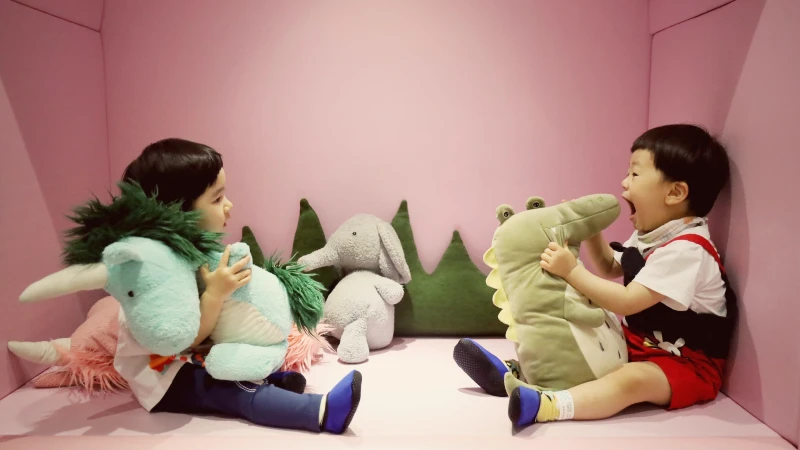Disclosure: This post may contain affiliate links, meaning we get a commission if you decide to make a purchase through our links, at no cost to you. Please read our disclosure for more info.
There is more to stuffed animals and plush toys than meets the eye. Beyond the soft, cuddly surface, these toys play a crucial role in fostering children’s emotions and overall development.
In This Post:
Comforting Companionship
A child’s first interaction with a stuffed animal creates an emotional bond that can have lasting effects on their wellbeing. These feelings of attachment fulfill a basic need for comfort and companionship and help kids feel secure. Interestingly, this bond often begins at a very young age, with infants as young as a few months old showing a preference for soft, plush toys over other objects. This is not just a matter of physical comfort; the consistency and reliability of a cuddly toy offer a sense of stability and familiarity in a child’s rapidly changing world.
Moreover, the role of stuffed animals in a child’s life evolves as they grow. For toddlers and preschoolers, these toys can become trusty companions that accompany them throughout the day, providing a sense of security in new or challenging situations. As children navigate the complexities of emotions and social interactions, their cuddly friends act as a constant, reassuring presence. This can be especially significant during transitions such as starting school or moving to a new home, where the comfort of a beloved toy can ease the stress of change.
Further delving into the psychological aspects, experts suggest that the relationship with a cuddly toy can be a child’s first step in understanding and developing relationships with others. It’s a safe way for children to explore concepts of care, love, and trust. In this context, the cuddly toy becomes more than just a plaything; it’s a fundamental part of a child’s journey in learning about relationships and emotional connections.
Security Objects
Stuffed animals often serve as ‘security objects’ that soothe children during difficult or unfamiliar situations. Whether it’s transitioning from a crib to a big kid’s bed, adapting to a new school environment, or coping with a loved one’s absence, having a cuddly toy to hold onto makes the experience less overwhelming.
Promoting Empathy and Compassion
Caring for a plush toy provides opportunities for children to practice empathy, compassion, and nurturing behaviors. As they pretend to feed, bathe, and put their cuddly toy to sleep, they’re also learning valuable life skills and understanding how to care for others empathetically.
Mirror Neurons Activation
Mirror neurons are brain cells responsible for helping us empathize with others. When children interact with their stuffed animals, these mirror neurons fire, preparing them for real-life interactions with people and pets. This early exposure to empathy enables kids to connect better with others and develop strong social relationships.
Supporting Self-Regulation and Emotional Expression
Stuffed animals enable kids to express their emotions freely and learn self-regulation techniques. By talking to their cuddly toys, children can safely vent their frustrations, fears, and concerns. This kind of communication helps them develop emotional resiliency, self-awareness, and coping skills. It’s akin to a therapeutic dialogue in a safe, controlled environment. Children often project their feelings onto the stuffed animal, making it easier to understand and manage their emotions. This process is instrumental in the development of emotional intelligence, allowing children to approach real-life situations with greater empathy and understanding.
Emotional Intelligence Development
Maintaining a strong connection with a stuffed animal helps children recognize and appreciate their own emotions and the feelings of others. As they begin to understand these complex concepts, they become more emotionally intelligent, which is essential for healthy relationships and personal growth.
Fostering Imagination and Playfulness
Plush toys inspire imaginative play and allow children to explore different roles, situations, and feelings creatively. Through these make-believe scenarios, kids learn social skills and emotional intelligence while letting their imaginations soar.
Storytelling and Roleplay
Stuffed animals often become characters in a child’s narrative, helping kids bring stories to life and hone their storytelling abilities. As children narrate adventures and act out various emotions with their cuddly toy as the protagonist, it opens up a whole new world of creative expression.
A Tool for Learning About Emotions
Some cuddly toys are specifically designed to expose children to different emotions through interactive features, colors, or facial expressions. Kids can learn to distinguish happy, sad, angry, and scared expressions on their plush friends, thereby enhancing their emotional vocabulary.
Comfort through Difficult Feelings
When a child experiences challenging emotions, a soft, huggable toy can provide comfort and reassurance. The familiar touch and smell of their beloved stuffed animal remind kids that they’re not alone during difficult moments.
- Boosts Mood: Research has shown that physical contact with something soft, like a plush toy, releases oxytocin, the ‘feel-good’ hormone. It’s no wonder cuddly toys play such a significant role in children’s emotional wellbeing.
- Resolve Conflicts: Stuffed animals can serve as neutral mediators during interpersonal conflicts between kids. Children might find it easier to communicate their feelings through the perspective of a plush toy, paving the way for conflict resolution and understanding.

